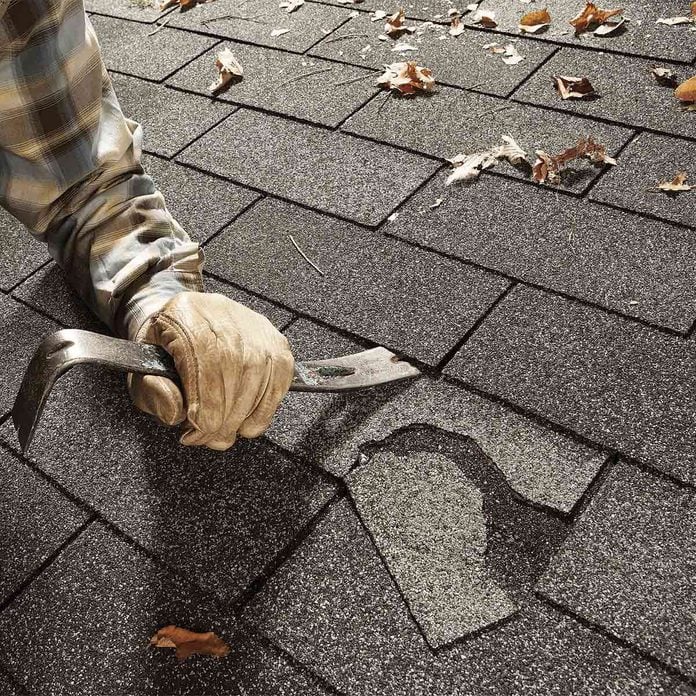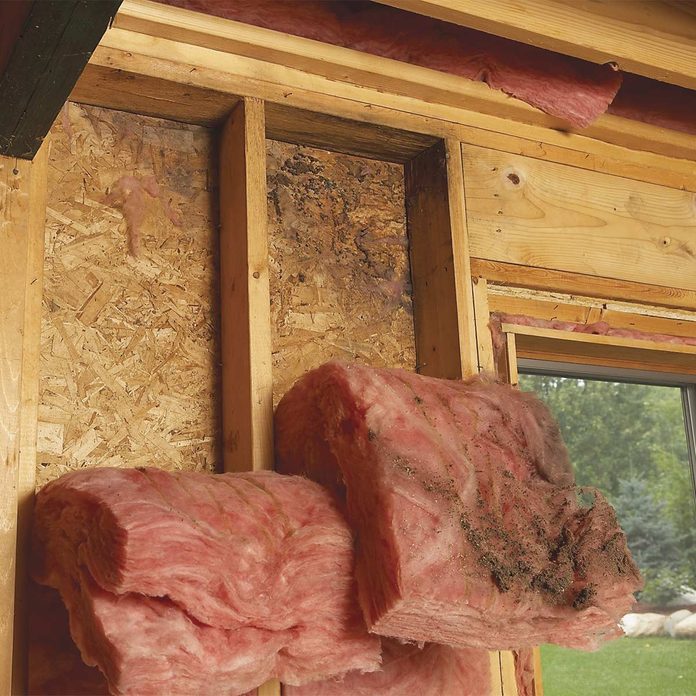
Damaged Plumbing Vent Boots
Plumbing vent boots can be all plastic, plastic and metal, or even two-piece metal units. Check plastic bases for cracks and metal bases for broken seams. Then examine the rubber boot surrounding the pipe. That can be rotted away or torn, allowing water to work its way into the house along the pipe. With any of these problems, you should buy a new vent boot to replace the old one. But if the nails at the base are missing or pulled free and the boot is in good shape, replace them with the rubber-washered screws used for metal roofing systems.

Ceiling Stains
If you have water stains that extend across ceilings or run down walls, the cause is probably a leaky roof. Tracking down the leak is the hard part; the roof leak repair is usually pretty easy. We’ll show you some simple tricks for finding and repairing most of the common types of leaky roofs. If you have a leaky roof, you’d better fix it immediately, even if it doesn’t bother you much or you’re getting a new roof next year. Even over a short time, small leaks can lead to big problems, such as mold, rotted framing and sheathing, destroyed insulation and damaged ceilings.

Shiners
If you can’t see any telltale flow marks and the ceiling stain is fairly small, look at the underside of the roof for ‘shiners.’ A shiner is a nail that missed the framing member. Moisture that escapes into the cold attic from the rooms below often condenses on cold nails. Sometimes you can spot this if you climb up into your attic on a cold night. The nails will look white because they’re frosted. When the attic heats up a bit during the day, the frost melts and drips, then the nails frost up at night again and so on. The solution is to simply clip the nail with a side-cutting pliers.

Damaged Shingles
A broken shingle is both ugly and a leak waiting to happen. But as long as you can find matching shingles (and you’re not afraid of heights), the repair is straightforward.

Dirty, Clogged Soffits
Attic ventilation is critical to the health of your house. It begins with soffit vents that inhale outside air—necessary to create an airflow that moves warm attic air out the roof vents. Once the air enters the soffit, it usually proceeds through an air chute or some other opening along the underside of the roof into the attic. The plastic air chutes (from home centers and building suppliers) in each rafter space keep the air path clear between the rafters and the roof sheathing. Clear soffits help to prevent moisture buildup and ultimately mold growth on your roof’s framing.

Mold Where Roof and Exterior Wall Meet
Kick-out flashing is critical where a roof edge meets a sidewall. Without it, roof runoff flows down the wall and possibly into the wall. This is worst when there is a door or a window below and water can seep behind the trim. You might not notice it for years, but eventually rot will destroy sheathing and framing. In extreme cases, the stucco is the only thing holding up the wall! Don’t wait for that to happen to you.

Rusted Gutters
Gutter leaks usually start at rusty spots or seams that have opened up because of expansion and contraction. If your gutter is still basically sound, the easiest way to stop the leak is by covering the damaged area with roof and gutter repair tape (available at home centers and hardware stores). First remove rust with a wire brush and scrape out tar with a putty knife.

Roof Vent Issues
Check for cracked housings on plastic roof vents and broken seams on metal ones. You might be tempted to throw caulk at the problem, but that solution won’t last long. There’s really no fix other than replacing the damaged vents. Also look for pulled or missing nails at the base’s bottom edge. Replace them with rubber-washered screws. In most cases, you can remove nails under the shingles on both sides of the vent to pull it free. There will be nails across the top of the vent too. Usually you can also work those loose without removing shingles. Screw the bottom in place with rubber-washered screws. Squeeze out a bead of caulk beneath the shingles on both sides of the vent to hold the shingles down and to add a water barrier. That’s much easier than renailing the shingles.

Loose Step Flashing
Step flashing is used along walls that intersect the roof. Each short section of flashing channels water over the shingle downhill from it. But if the flashing rusts through, or a piece comes loose, water will run right behind it, and into the house it goes. Learn how to install step flashing.

Mold on Exterior Walls
If mold is growing on an exterior wall, there could be a leak in the roof. Measure from the moldy area to a reference point like a door, then find the spot on the other side of the wall or ceiling. Look for ground sloping toward the house and down-spouts emptying next to the wall.

Holes Drilled on Purpose
Tiny holes in shingles are sneaky because they can cause rot and other damage for years before you notice the obvious signs of a leak. You might find holes left over from satellite dish or antenna mounting brackets or just about anything. And exposed, misplaced roofing nails should be pulled and the holes patched. Small holes are simple to fix, but the fix isn’t to inject caulk in the hole. You’ll fix this one with flashing.

Missing Gutter Apron
When water flows off the edge of your roof, some of it clings to the underside of the shingles and dribbles toward the fascia. If you have gutters but no gutter apron to stop the water, it will wick behind the gutter. Eventually the fascia, soffits and even the roof sheathing will rot. You may see water stains below the gutter on the fascia and soffit. This is a sure sign that the gutter apron is missing.

Rusted Chimney Flashing
All kinds of bad things can happen around brick chimneys. Flashing around chimneys can rust through if it’s galvanized steel, especially at the 90-degree bend at the bottom. A quick but fairly long-term fix is to simply slip new flashing under the old rusted stuff. That way any water that seeps through will be diverted.

Stains Around a Bathroom Fan
Water stains on the ceiling around your bath fan may indicate a leak coming from the vent cap on your roof, but condensation is the more likely culprit. If bath fan ducting isn’t properly insulated, the moist air from your house will condense inside the duct.

Hail Damage
When a large hailstone hits an asphalt shingle, it can tear or even puncture the shingle. But usually, it just knocks granules off the surface. When a shingle loses its protective layer of granules, UV rays from the sun begin to destroy it. More granules fall off around the damaged spot and the bruise grows.